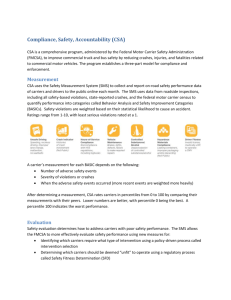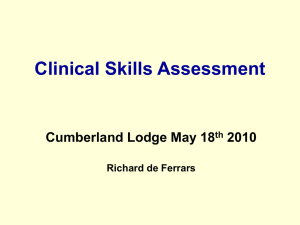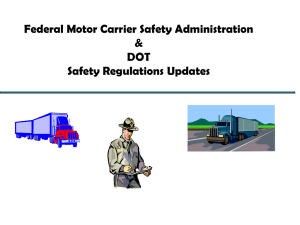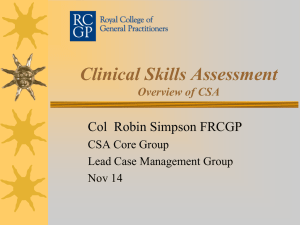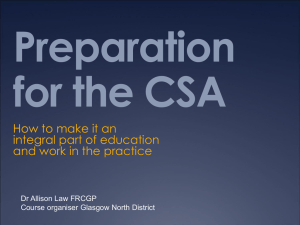CSA Program Overview
advertisement
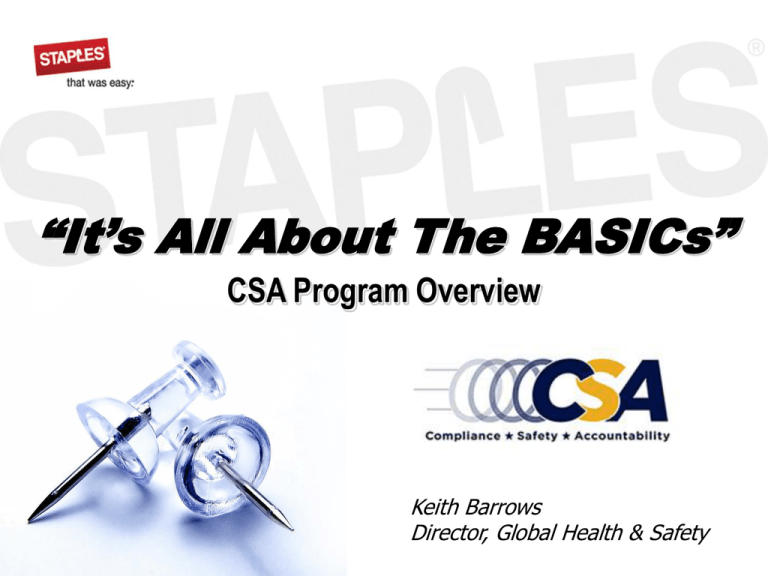
“It’s All About The BASICs” CSA Program Overview Keith Barrows Director, Global Health & Safety Today’s Agenda What is CSA? CSA Program Overview • Behavioral Analysis & Safety Improvement Categories (BASICs) • The Safety Measurement System (SMS) The 7 BASICs FMCSA Interventions How to Research Your Score How to Contest a Violation (DataQs) Wrap Up/ Q&A Ask These Guys about CSA? Operations suspended in March 2013 Before we begin…… Test your knowledge of CSA FMCSA data is collected from which of the following sources? a)Roadside Inspections b)DOT recordable crashes c)FMCSA investigations d)All of the above We did mention this was interactive..right? A driver’s BASIC scores ___________. a)Are not reset if they change carriers (jobs) b)Directly impact their CDL status c)Will never change d)Cannot be appealed or amended Are you impressing your colleagues? Data collection, Safety Measurement, Safety Evaluation and Intervention are_____________. a)The 4 BASICs of the CSA system b)The 4 statistical tools used to monitor drivers c)The 4 components of the CSA system d)The 4 categories of violations a carrier can be given Are the questions getting harder? Why are reckless driving violations given a higher severity weights by the FMCSA? a)Research has shown that drivers with a reckless driving violation are highly likely to be involved in a crash b)Research has shown that drivers with a reckless driving violation are highly unlikely to be involved in a crash c)Reckless driving violations are not given a high severity weight by FMCSA d)Reckless driving violations are only given a high severity weight when they result in a crash Last one…… I promise. The Hours of Service compliance BASIC includes an out-of-service penalty or “kicker”. What other BASIC includes this penalty? a)Unsafe Driving BASIC b)Controlled Substances and Alcohol BASIC c)Crash Indicator BASIC d)Hazardous Materials compliance BASIC What is CSA? Compliance, Safety, Accountability (CSA) is a Federal Motor Carrier Safety Administration (FMCSA) initiative to improve both carrier & driver safety, as well as, reduce crashes, injuries, and fatalities that are related to commercial motor vehicles. Rolled out in December 2010, the program uses the data and information collected during Roadside Inspections and carrier investigations to evaluate safety performance and proactively address safety problems before they lead to tragedies on the highways. CSA Program Overview There are 4 components to CSA. They are: 1. 2. 3. 4. Data collection Safety Measurement Safety Evaluation Intervention We’ll review: • • • How safety data is collected, What FMCSA does with the data and, How to keep your scores low CSA Program Overview - BASICs At the heart of the CSA safety measurement process are 7 categories of ‘safety related behaviors’ called BASICs 1.Unsafe Driving – Speeding, following too close, texting while driving 2.HOS* compliance – log violations, driving 3.Driver Fitness – not having proper license or endorsement, not having valid medical card 4.Controlled Substances and Alcohol – operating a CMV while impaired by or in possession of illegal drugs, alcohol or any other controlled substance * Hours of service CSA Program Overview - BASICs 5. Vehicle Maintenance – Cargo securement, equipment inspections and maintenance regulations 6. Hazardous Materials compliance – Handling, securing and documentation of hazardous materials 7. Crash Indicator– Documents and tracks DOT-recordable crashes for both drivers and carriers CSA Program Overview - BASICs Knowing the BASICs means knowing; • What they are, • How they are scored, • What those scores can mean for you and your drivers We’ll come back to the BASICs but, first we need to review the Safety Measurement System (SMS) The Safety Measurement System (SMS) CSA Program Overview - SMS The Safety Measurement System (SMS) quantifies the onroad safety performance of carriers and drivers to identify candidates for interventions, determine the specific safety problems that a carrier or driver exhibits, and to monitor whether safety problems are improving or worsening. The SMS uses a motor carrier’s data from roadside inspections, State-reported crashes (DOT recordable), and the Federal motor carrier census to quantify performance in the 7 Behavior Analysis and Safety Improvement Categories (BASICs). CSA Program Overview - SMS • Roadside Inspections (RSI) occur at weigh stations or as a result of moving violations. • 3.5 Million RSIs performed/year • RSIs generally have two outcomes –No violations or “clean inspection” –Violations noted/written CSA Program Overview - SMS When a violation is written, it is assigned a numerical value for CSA scoring purposes. The value is obtained as follows: Severity weighting – Using a scale of 1 – 10, each violation is assigned a value based on its correlation with crash causation (a value of 10 is most severe) If the violation also results in an Out of Service (OOS) order there is a penalty or “kicker” of 2 points applied to the severity. (applies to HOS, Driver Fitness, Vehicle Maintenance and Hazardous Materials BASICs) CSA Program Overview - SMS A Time weighting is then applied to the violation. This value ranges from 1 – 3 (more emphasis is placed on recent violations) The Full Violation Value (FV) is calculated as follows: FV = Severity weight (+ OOS penalty) x Time weight The total of all FV’s yields the Basic Measure The Basic Measure is not your score! CSA Program Overview - SMS After the BASIC measure is determined, the carrier is then placed in a Safety Event Group (SEG) or peer group (e.g., other carriers with similar numbers of inspections and fleet size). Percentiles from 0 to 100 are then determined by comparing the BASIC measurements of the carrier to the measurements of other carriers in the peer group. A percentile of 100 indicates the worst performance Like golf… a lower score is BETTER. CSA Program Overview - SMS In summary: Safety Measurement and BASIC score is influenced by: The number of adverse safety events (violations related to that BASIC or crashes) The severity of violations or crashes When the safety events occurred (more recent events are weighted more heavily). Important fact! Driver scores are confidential…Carrier scores are PUBLIC information! Behavior Analysis & Safety Improvement Categories (BASICs) Unsafe Driving — Operation of commercial motor vehicles (CMVs) by drivers in a dangerous or careless manner. Example violations: Speeding, reckless driving, improper lane change, and inattention. This is a standalone BASIC, meaning it is most associated with crash causation. Violations tend to have more severe weightings Hours-of-Service (HOS) Compliance — Operation of CMVs by drivers who are ill, fatigued, or in non-compliance with the HOS regulations. This BASIC includes violations of regulations pertaining to log books. This is also a standalone BASIC Driver Fitness — Operation of CMVs by drivers who are unfit to operate a CMV due to lack of training, experience, or medical qualifications. Example violations: Failure to have a valid and appropriate driver’s license, endorsement and/or being medically unqualified to operate a CMV. This BASIC has nothing to do with physical fitness. It should be called Drive Qualification. Behavior Analysis & Safety Improvement Categories (BASICs) Controlled Substances/Alcohol — Operation of CMVs by drivers who are impaired due to alcohol, illegal drugs, and misuse of prescription or over-the-counter medications. (FMCSR Parts 382 and 392) Vehicle Maintenance — Failure to properly maintain a CMV and/or properly prevent shifting loads. Example violations: Brakes, lights, and other mechanical defects, failure to make required repairs, and improper load securement. Hazardous Materials (HM) Compliance — Unsafe handling of HM on a CMV. Example violations: Release of HM from package, no shipping papers (carrier), and no placards/markings when required. (Hazardous Materials Regulations Parts 171, 172, 173, 177, 178, 179, and 180) Crash Indicator — Histories or patterns of high crash involvement, including frequency and severity. It is based on information from State-reported crashes regardless of fault Interventions Before CSA the primary, if not sole, form of intervention was a comprehensive on-site audit Under CSA, a DOT intervention is now typically issued when a carrier exceeds the established safety threshold for a particular BASIC Other intervention triggers include: – Complaints – High crash rates – Fatal crashes Interventions Interventions increase in severity as more serious safety issues are identified There are 3 categories of interventions Early Contact – Warning Letter – Targeted Roadside Inspections Investigations – Off site – Focused on-site – Comprehensive on-site Follow-on – Cooperative Safety Plan – Notice of Violation – Notice of Claim – Operations Out of Service Order CSA – Navigating the Portal Let’s spend a few minutes reviewing CSA scores. We’ll view both the private and public data…… Because the lawyers and media definitely will! http://ai.fmcsa.dot.gov/sms/ DataQs – Are You Up For A Challenge? If a carrier believes a citation was issued in error or due to extenuating circumstances beyond a driver’s control, a request for data review (RDR) can be filed using the DataQs website. This process helps ensure the accuracy of the information collected and tracked by the FMCSA and it’ll help make certain that you’re not being penalized for something your driver didn’t do. Before filing a DataQs challenge, be sure you’re keeping an eye on your CSA score. It’s a good idea to set a regular schedule for reviewing your score and follow up with a process for challenging any scores that don’t seem legitimate. https://dataqs.fmcsa.dot.gov DataQs – Tips for Successful Challenges 1. Make the request as timely as possible. While there is no time limit on challenging a piece of information contributing to your CSA score, getting the challenge in before two years is up, when it falls off the CSA radar is a no-brainer. 2. Specify the correct RDR Type. When inputting your RDR, make sure you select the appropriate action type, delineating that it has to do with a particular violation, an inspection, crash, etc. 3. Provide the accurate report number. This refers to your inspection report — giving the accurate number will help the reviewing state agency determine whether “this inspection or crash actually [belongs] to their agency. Is it a valid report number? DataQs – Tips for Successful Challenges 4. Provide a clear and detailed explanation of what you want reviewed. In the event that the initial category is insufficient to cover the full scope of what is needed in your review, use the Explanation section to elaborate on problems. There may be two or three other things incorrect on the inspection report. It’s important to have the reviewing state agency correct them all…. Remember, they have just as much interest in ensuring all the data on that report is as accurate as possible. 5. Keep RDRs professional and detailed. 6. Make factual statements. Whenever possible, stick to the facts of the case without injecting opinion/emotion into the request. DataQs – Tips for Successful Challenges 7. Ask for additional time as necessary. If you’re waiting on information, simply fire off an email to the reviewer to let him/her know you’re working on getting the data. More likely than not, they will work with you. 8. Provide as much possible supporting documentation that is valid and relevant. Pictures documenting a supposed maintenance violation, for instance. In events where a violation or inspection is wrongly assigned to your own DOT number or the wrong driver, providing bills of lading, truck registration documents and/or driver’s license, rental or lease agreement copies may be appropriate. This is one of the most important things that you can do to help resolve an RDR. DataQs – Tips for Successful Challenges 9. Follow up as appropriate. It is your right to appeal any final decision made by a state’s DataQs handler. Two states, Arizona and New Hampshire, have set up official boards with industry representatives in addition to law enforcement reps to review these appeals. The remainder of states handle them less formally, but will re-review your information. Thank You! Questions?


